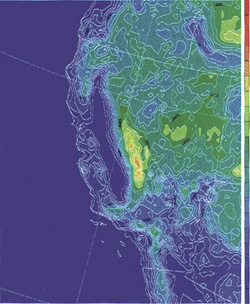
Advanced Computing, page three

Regional climate system models, like this one of California, can simulate the temporal and spatial precipitation and river flow of a local area at a resolution fine enough to aid researchers in accurately simulating specific local events, such as flood danger in a particular river valley.
The two have developed software for adaptive mesh refinement, a technique that applies maximum computing power in a fine mesh to critical areas, but a coarse mesh to less important ones. Bell used the tools to create detailed 3-D simulations of turbulent methane combustion, involving more than 80 chemical reactions that must be computationally dissected as they occur.
Flame modeling belongs to the class of interface-dynamics problems, in which an instability arising at an interface between two fluids causes the interface to grow and change. In addition to turbulence, Bell and Colella’s adaptive mesh refinement software has been applied to shock physics, astrophysics, fluid flow through porous media, and other studies — not least, climate modeling.
Making climate modeling predictive is a multiscalar challenge. Ferdinand Baer of the University of Maryland and Joseph Tribbia of the National Center for Atmospheric Research used NERSC to develop the Spectral Element Atmospheric Model to incorporate local mesh refinement within global climate models, long known for running at too coarse a resolution for meaningful prediction (modeling the Rocky Mountains as a single barrier, for example, while overlooking details like the Sierra Nevada). Their method increases resolution in dynamically significant areas like complex topographies, allowing regional resolution to enrich the global model.
The California Water Resources Research and Applications Center, whose lead scientist is Norman Miller of Berkeley Lab’s Earth Sciences Division, models regional climate impacts on stream flow, water quality, and agriculture. The Regional Climate System Model pioneered by Miller and Jinwon Kim downscales global models to accurately simulate events on the local scale, such as flood danger in a particular river valley.
Understanding exchanges between land and atmosphere can improve models from the ground up. The Lab’s Atmospheric Radiation Measurement program in the Great Plains, directed by the Earth Sciences Division’s Margaret Torn, scales predictions of carbon, water, and energy flux — from individual land plots to entire regions. Torn is head of the Lab’s Climate Change and Carbon Management Program, which coordinates climate research in the Earth Sciences, Engineering, Environmental Energy Technologies, and NERSC divisions. Under her initiative, the program designed the first regional climate and terrestrial ecosystem model coupling the land surface to the mesoscale; as a consequence, Berkeley Lab’s climate-change simulations have achieved unprecedented fine resolution.
No matter how inaccessible, from the ionization of a helium atom to the thermonuclear explosion of a distant supernova, no scientific problem that can be well characterized is impossible to compute.